NEET Biology Short Notes PDF Photosynthesis In Higher Plants
Photosynthesis: Photosynthesis (photo = light, synthesis = putting together) is the process of the formation of simple sugars by green plants, some bacteria, and some protistans from water, soil, or from carbon dioxide in the air in the presence of sunlight and chlorophyll.
- By the process of photosynthesis, solar energy is trapped by autotrophic organisms and stored in the form of chemical energy. Annually, about 75 x 1012 kg of carbon (in the form of CO2) is fixed through photosynthesis, producing about 1700 million tonnes of dry matter.
- About 90% of it is carried out in the oceans (largely by phytoplanktons and algae). Only 0.2% of the light energy falling on earth is utilized by photosynthetic organisms. Photosynthesis first appeared in cyanobacteria.
” photosynthesis in higher plant”
NEET Biology Short Notes Contributions By Some Scientists
Joseph Priestley: Vegetation purifies (dephlogiston) air.
Jan Ingen-Housz: Discovered photosynthesis.
Lavoisier: Phlogiston is CO2 and dephlogiston is O2.
de Saussure: H2O is involved in photosynthesis, CO2 is used and O2 is evolved.
Dutrochet: The established connection between chlorophyll and photosynthesis.
Ruben, Kamen: Using O18 (H2O), he found that O2 involved in the photosynthesis comes from H2O (in Chlorella).
Read and Learn More NEET Biology Notes
NEET Biology Important Topics Photosynthetic Pigments
The two types of photosynthetic pigments present in higher plants are chlorophyll (discovered by Pelletier and Caventau) and carotenoids.
Chlorophyll: Chlorophylls are specialized lipid molecules embedded in the thylakoid membrane. They are the main pigment concerned with the harvesting or trapping of solar energy. Amoff and Allen (1966) recognized nine types of chlorophyll:
- Chlorophyll-a,
- Chlorophyll-b,
- Chlorophyll-c,
- Chlorophyll-d,
- Chlorophyll-e,
- Bacteriochiorophyll-a,
- Bacteriochlorophyll-b,
- Chlorobium chlorophyll-650, and
- Chlorobium chlorophyll-666.
Out of these, the two important types of chlorophyll found in green plants are chlorophyll-a and chlorophyll-b.
Chlorophyll-a: universal pigment found in all green plants (C55H72O5N4Mg).
Chlorophyll-b: found in green algae and higher plants (C55H70O6N4Mg).
Chlorophyll-c: found in diatoms, dinoflagellates, and brown algae (C55H32O5N4Mg).
Chlorophyll-d: found in red algae.
The chlorophyll molecule is asymmetrical and consists of two parts:
- Porphyrin head (15 x 15 Å; hydrophilic)
- Phylol fail (20 Å; hydrophobic)
The porphyrin ring is a Mat. square structure containing four smaller pyrrole rings (tetrapyrrole) with a magnesium atom at the center. The porphyrin ring has several side groups which alter the properties of the pigment. In chlorophyll-a, there is a -CH3 (methyl) group, while in chlorophyll-b, it is replaced by – CHO (aldehyde) group.
” photosynthesis in higher plants class 11 notes pdf download”
An isocyclic cyclopentanone ring is also attached to the third pyrrole group. The head is joined to a long hydrocarbon tail (phylol). Phylol esterification is absent in chlorophyll-c.
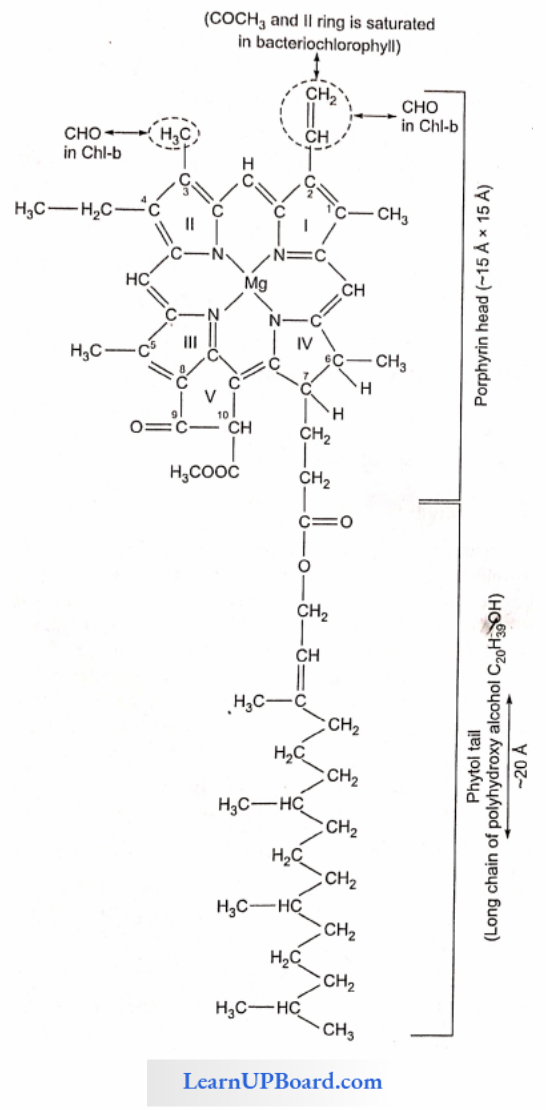
Chloiophyll-a is the most abundant photosynthetic pigment It is the only pigment found in all photosynthetic plants Chlorophylls absorb light near both ends of the visible spectrum, the blue and red light, and transmit or reflect green light, Therefore, these appear to be green in color.
Chlorophylls are synthesized from the precursor protochlorophyll. Its synthesis starts from glycine and succinyl CoA.
Fluorescence: Isolated chlorophyll-a when dissolved in organic solvents and exposed to light emits red color immediately. It is called fluorescence. It is, in fact, a manifestation of loss of light energy absorbed in excess. Actually, when the absorbed energy is not utilized for a purpose (phosphorylation), it is emitted as radiations of longer wavelength in green plants. Of course, this is utilized to synthesize chemical energy (ATP).
Carotenoids: Carotenoids arc yellow to orange pigments and are specialized lipids that absorb light strongly in the blue-violet range. These are called shield pigments as they protect chlorophyll from photo-oxidation (photobleaching) by the light of high intensity and also from oxygen produced during photosynthesis. These absorb light and transfer it to chlorophyll for use in pho¬tosynthesis, and therefore, function as a light-harvesting complex. Carotenoids are of two types:
- Carotenes (C40H56) are orange in color and xanthophylls are yellow in color. Carotenes are hydrocarbons, most of them being tetraterpenes, for example, lycopene
- Xanthophylls (C40H56O2) are very similar to carotenes but contain oxygen, for example, violaxanthin, and fucoxanthin.
Phycobilins: Phycobilins are proteinaceous pigments found in phycobilisomes. They are soluble in hot water and do not contain magnesium and tail. They are generally of two types: phycocyanin (for example, blue-green algae) and phycoerythrin (for example, red algae). These pigments are accessory pigments and also help in chromatic adaptation (Gaidukov phenomenon).
photosynthesis in higher plants short notes
Quantasome: Park and Biggins (1964) loaned the term quantasome for a group of pigment molecules required for carrying out a photochemical reaction. These are situated as small units on the membranes of thylakoids. Each quantasome consists of about 230 chlorophyll molecules, carotenoids, quinone compounds, sulpholipids, phospholipids, proteins, etc.
NEET Biology Important Topics Absorption And Action Spectra
Different plant pigments absorb only certain wavelengths of light and these wavelengths are not absorbed at the same rate. A curve obtained by plotting the amount of absorption to different wavelengths of light by a particular pigment is called an absorption spectrum.
An action spectrum is a curve showing the effectiveness of different wavelengths of light in stimulating the process being investigated. The effectiveness of different wavelengths of light on photosynthesis is measured and plotted by quantum yield or amount of action (expressed through CO2 reduction, O2 evolution, etc.)
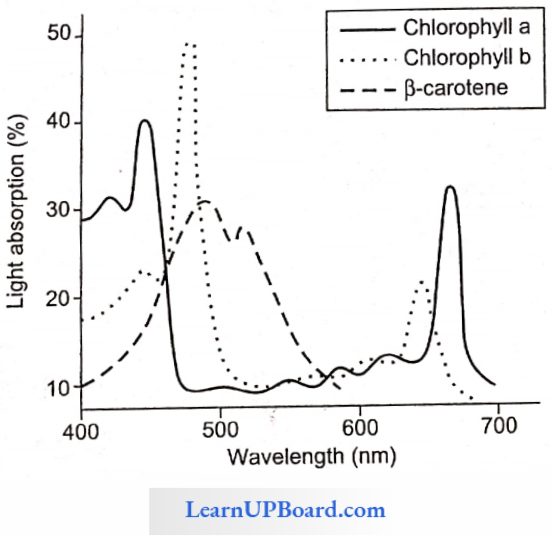
Hill Reaction: Hill working on Stellana media demonstrated that the evolution of O2 occurs from illuminated chloroplast in the presence of hydrogen or electron acceptors but in the absence of CO2, it produces assimilatory power for use in CO2 assimilation. Hill reaction is now considered to be equivalent to light reaction. Hill oxidants are hydrogen acceptors. The common ones are ferricyanide, benzoquinone, dichlorophenol indophenol, NADP+ (natural H+ acceptor in photosynthesis).
Quantum Yield: It is the number of O2 produced per quantum of light absorbed. It represents the rate of photosynthesis.
Quantum Requirement: It is the number of light quanta needed for the production of one O2 molecule or reduction of one O2 molecule.
Red Drop: Emerson measured quantum yield in Chlorella by exposing it to different monochromatic light. The yield was almost constant in all wavelengths but dropped suddenly in red light. It is called red drop.
Enhancement Effect: Emerson worked on chlorella and gave the concept of two photosystems. When Emerson and other scientists provided monochromatic light, then quantum yield suddenly dropped down (called red drop). When Emerson gave combined light, then photosynthesis increased. This is called the Emerson enhancement effect.
- 680 nm ↑: Red drop effect
- 680 nm ↓ + 680 nm ↑: Emerson effect
Thus, both lights had a synergistic effect, i.e., one helped the other. It leads to the conclusion that two groups of pigments, one absorbing in the lower range and the other absorbing in the higher range of wavelengths, are involved in photosynthesis and are called pigment systems.
NEET Biology Important Topics Pigment Systems
It is a group of 250-100 pigment molecules having chlorophyll- a, chlorophyll-b, carotenoids, etc. One molecule of chlorophyll-a functions as a reaction center or trapping center and the other acts as a light-harvesting complex (LHC) or antenna molecule. These antenna molecules collect light energy and transfer this energy (by inductive resonance process) to the reaction center where the primary photochemical act occurs (quantum conversion), i.e., absorption of a photon and release of an electron.
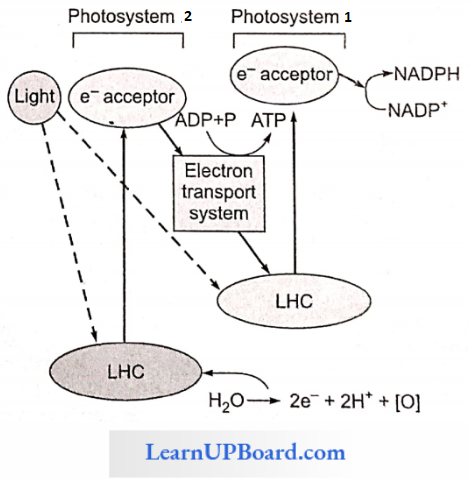
Differences Between Pigment Systems 1 And 2
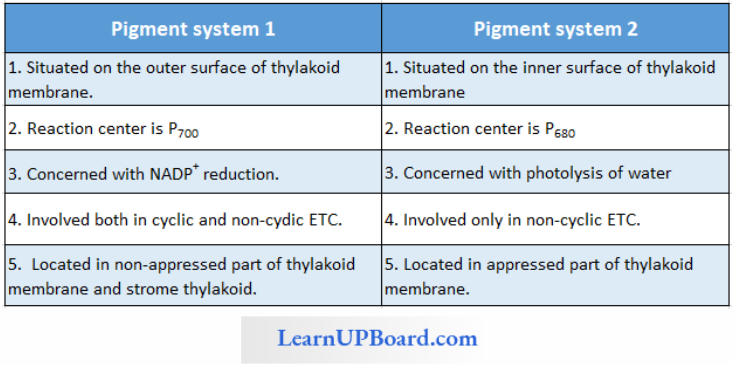
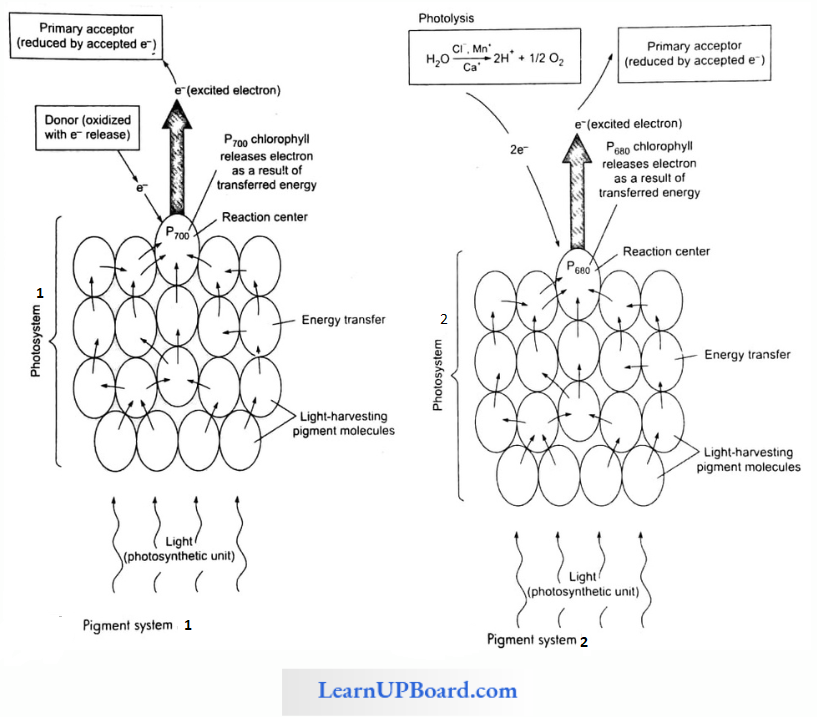
NEET Biology Important Topics Photolysis Of H2O
The photolysis of water occurs in the lumen of the thylakoid and requires minerals Mn+, CI–, Ca+2, and an oxygen-evolving complex (OEC).
2H2O → 4H+ + 4e– + O2
Released electrons are attracted toward reduced reaction center P680 of PS-2, while H+ accumulates in the lumen and finally reduces NADP.
NEET Biology Important Topics Mechanism Of Photosynthesis
Photosynthesis occurs In Two Phases:
- Light Reaction: Solar energy is trapped by chlorophyll and is stored in the form of chemical energy (ATP) and as reducing power (NADPH).
- Bark Reaction: Reducing capacity or NADPH and the energy of ATP are utilized in the conversion of CO2 to carbohydrates.
Warburg and others, using reaction inhibitors, proved that light and dark reactions occur independently.
1. Light Reaction: Emerson and Arnold (1932) subjected unicellular algae, Chlorella, to brief flashes of light or continued light at high intensities and observed O2 evolution The extent of photosynthesis (per unit of light energy provided to plant) was higher when light and dark periods were alternated (photosynthetic efficiency increases in intermittent light).
- It showed that the process of photosynthesis consisted of distinct light and dark reactions (the products of the light phase are not utilized immediately in the dark phase, so photosynthetic efficiency decreases in continuous saturating light).
- During Photosynthesis, 264 g of CO2 and 216 g of water are utilized to produce 108 g of water and 192 g of O2.
Redox Potential: It is the tendency of an atom/molecule having low redox potential to lose electrons (electron donors) while those with high redox potential to accept electrons (gain electrons). Hence, electrons move from substances having low redox potentials to those having high redox potentials.
Assimilatory Power: NADPH + H+ and ATP produced in light reaction constitute assimilatory power.
Photophosphorylation: The generation of ATP in light reaction is called photophosphorylation. It was first explained by P. Mitchell who gave chemiosmotic theory. As a result of photolysis and quinone pump, H+ concentration in the thylakoid lumen increases by 1000-2000 times, and as a result, a proton motive force develops. This force is responsible for ATP synthesis on the head of CF0-CF1 a particle plugged into the thylakoid membrane.
Difference Between Photophosphorylation
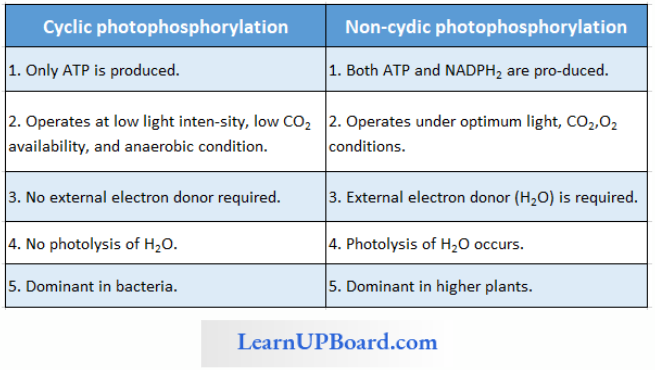
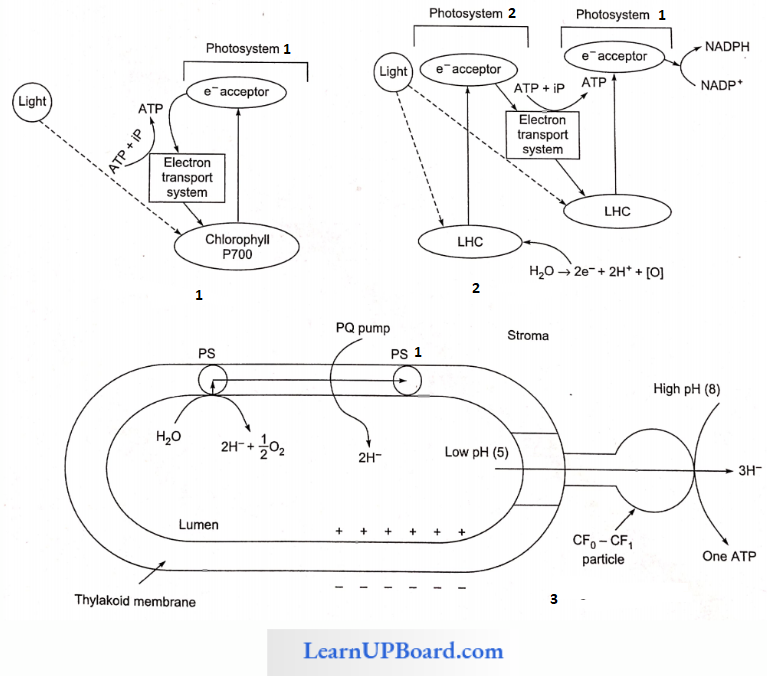
2. Dark Reaction (C3 Cycle, Calvin Cycle): The biosynthetic phase (dark reaction) is so-called because it is independent of light. The ATP and NADPH produced by the light reactions are utilized in the dark reaction to reduce carbon dioxide to carbohydrates by a process called carbon fixation. It occurs in the stroma. The process comprises a series of reactions controlled by enzymes. The sequence of these reactions was determined in Chlorella and Scenedesmus by Calvin, Benson, and
Bassham uses radioactive carbon 14C and techniques such as chromatography and autoradiography. Therefore, it is also known as the Calvin cycle or Calvin Benson cycle. The enzyme for CO2 fixation is RuBisCo. It is a large enzyme found in stroma. It is the most abundant protein on earth and constitutes 16% of the chloroplastic protein. It shows a bifunctional nature having both carboxylase and oxygenase activity. The dark reaction is also known as the black reaction. The whole reaction can be studied in three parts
photosynthesis notes class 11
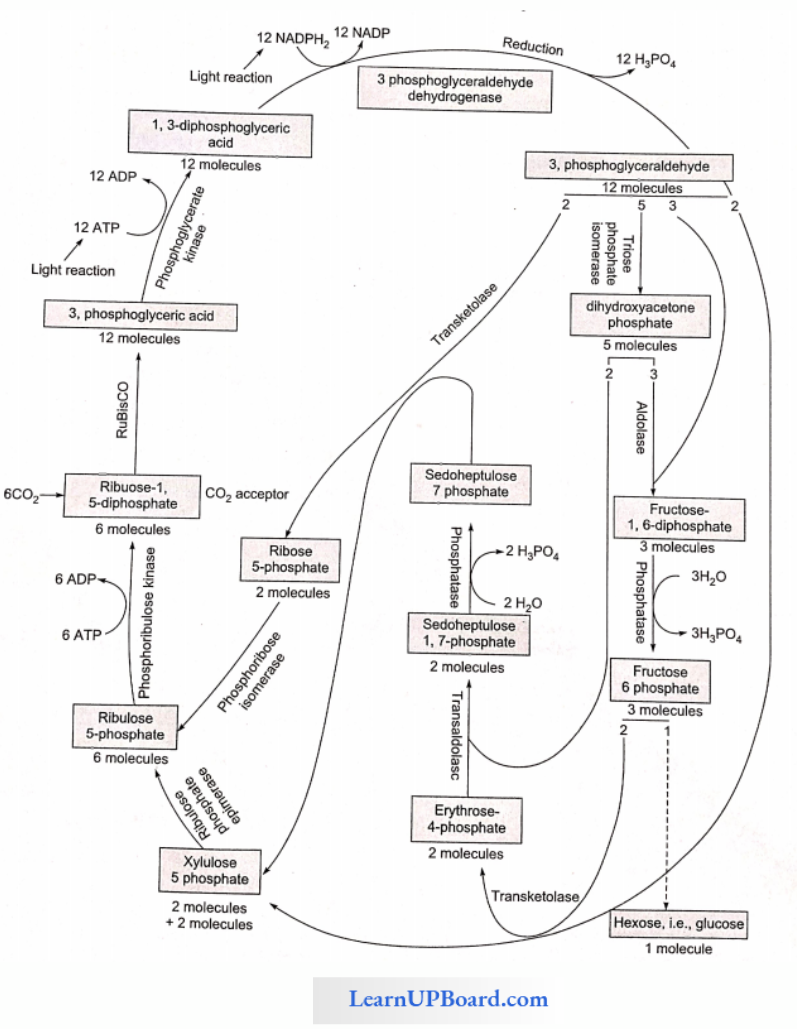
- Carboxylation (acceptance of CO2 by RuBP—CO2 acceptor)
- Glycolytic reversal
- Regeneration of RuBP
The formation of a molecule of glucose requires 18 ATPs and 12 NADPH + H+ (or to reduce 60O2).
NEET Biology Important Topics Photorespiration
Since 1920, it has been known that higher concentrations of oxygen inhibit photosynthesis (Warburg effect). However, the reason was discovered in 1971. It was shown that RuBP carboxylase (RuBisCo) accepts not only CO2 but also oxygen as a substrate. If oxygen is accepted, the following reaction occurs:
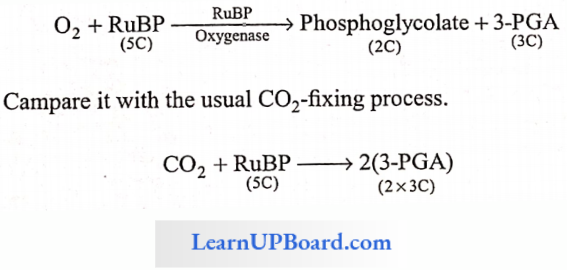
Oxygen is a competitive inhibitor of CO2 fixation. Any increase in O2 concentration would favor the uptake of oxygen rather than CO2, and thus inhibit photosynthesis.
- The phosphoglycolate is immediately converted to glycolate. The peroxisomes present in the cell metabolize the glycolate into glycine and glycine into seine and carbon dioxide without the production of ATP or NADPH. This process is called photorespiration. Photorespiration is defined as a light-dependent uptake of oxygen and the output of carbon dioxide.
- Photorespiration has no relation with normal respiration called dark respiration. Both of these resemble only in one point, i.e., O2 is used and CO2 is released. Photorespiration depends upon light for the supply of RuBP. RuBP is available only when photosynthesis is operating, as RuBP is regenerated in the Calvin cycle.
- The function of photorespiration is to recover some of the carbon from the excess glycolate. However, there is a wasteful loss of carbon as CO2 (when glycine is oxidized to serine) and energy. Although ATP is produced when glycine is oxidized to serine, the overall process is energy-consuming. Up to one-fourth of the photosynthetically fixed CO2 may be lost by photorespiration.
With the increase in temperature, light intensity, and oxygen concentration, the affinity of RuBisCo for CO2 decreases, and its affinity for oxygen increases. Thus, a rise in the temperature means more loss of photosynthetically fixed carbon by photorespiration. Photorespiration reduces the potential yield of plants growing in the tropics by 30-40%.
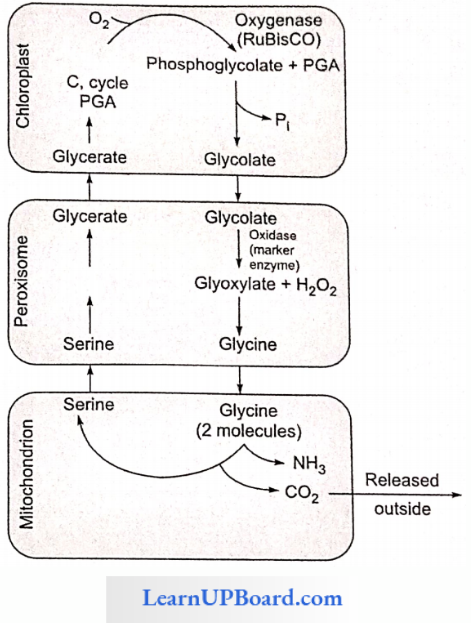
Differences Between Normal Respiration And Photorespiration
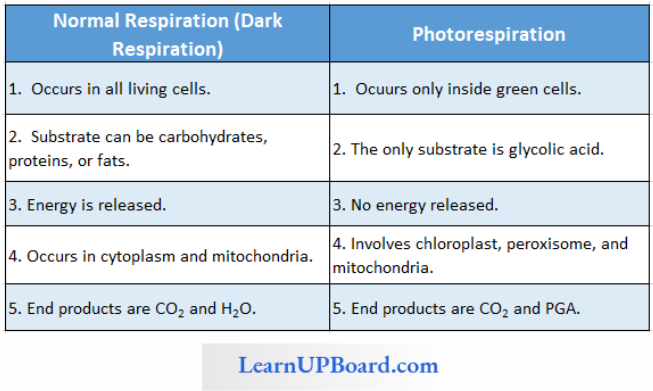
NEET Biology Important Topics Dicarboxylic Acid Cycle (Cooperative photosynthesis)
H.P. Kortschak and C.E. Hartt (1965) found that in sugarcane (a tropical plant), leaves removed CO2 more efficiently from the atmosphere, and the first products of photosynthesis were acids containing four-carbon acids (for example, malic, oxaloacetate, and aspartic), rather than the 3C acid PGA.
Since then, the same has been found true for many important tropical plants including monocots (such as maize, Sorghum, and Eleusine) as well as dicots (such as Amaranthus and Euphorbia sp.). These plants are called C4 plants. On the other hand, the plants in which the first product for photosynthesis is O3 acid PGA are called C3 plants. Calvin cycle, in fact, is a C3 pathway.
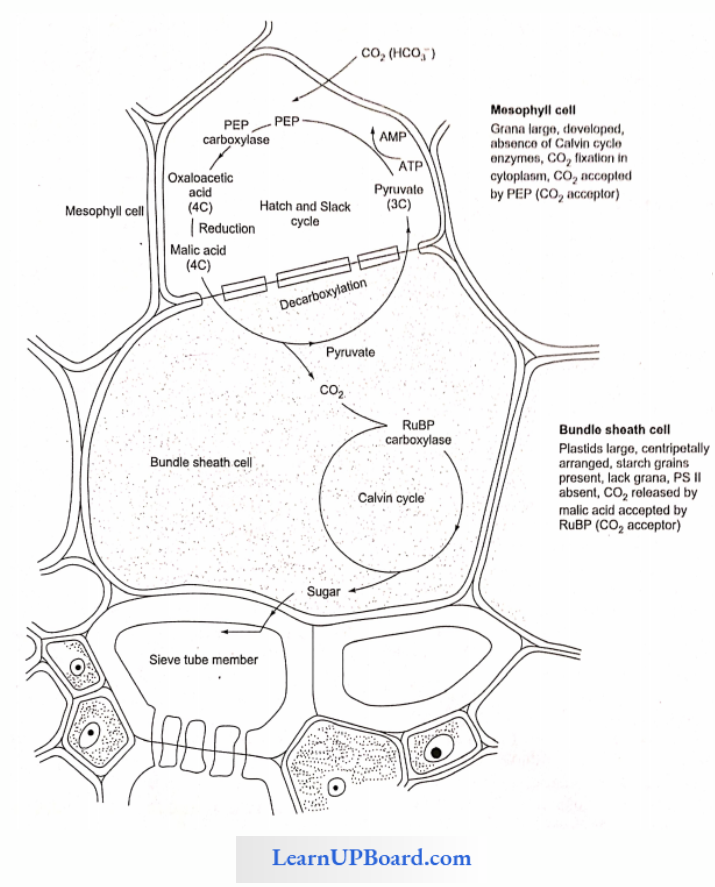
In 1966, two Australian scientists, Hatch and Slack, showed that C4 plants were much more efficient in CO2 utilization than C3 plants. Such plants do not show photorespiration. In 1967, Hatch and Slack explained the manner of CO2 fixation and reduction in such plants. The new carbon pathway in C4 plants is called the Hatch-Slack pathway.
- The C4 plants possess a characteristic leaf anatomy. Their vascular bundles are surrounded by two rings of cells. The inner ring, called bundle sheath cells, contains starch-rich chloroplasts lacking grana which differ from those in the mesophyll cells that make the outer ring.
- The chloroplasts in these plants are, therefore, called dimorphic. This peculiar anatomy is called kranz anatomy because kranz means crown or halo, which refers to two distinct rings of cells. Correlation between Kranz anatomy and C4 photosynthesis was established by Dowton and Treguna.
Since every CO2 molecule has to be fixed twice, hence C4 pathway is more energy-consuming than the C3 pathway. The C pathway requires 18 ATP and 12 NADPH2, for the synthesis of one molecule of glucose.
On the other hand, the C4 pathway requires 30 ATP and 12 NADPH2. However since otherwise tropical plants lose more than one-fourth of the photosynthetic carbon in photorespiration, the C4 pathway is an adaptive mechanism for minimizing the loss.
NEET Biology Important Topics Cam Cycle (In Succulent Plants)
The leaves of plants belonging to the Crassulaceae family. for example. certain cacti, orchids, pineapple, Kahuwhoe, and Scdum undergo crassulacean acid metabolism and such plants are called Crassulacean acid metabolism (CAM) plants.
- All CAM plants are succulent inhabit. As such, stomata remain open in night and closed during the day (scotoactive stomata).
- CO2 is fixed during the night (dark) to malic acid via PEP carboxylase. This CO2 comes from respiration (breakdown of starch) as well as from the atmosphere. Malic acid gets stored in vacuoles.
- The CAM plants also contain the enzyme of the Calvin cycle. Thus, during the daytime, malic acid breaks into pyruvate and CO2. While CO2 enters the Calvin cycle, pyruvate is used up to regenerate PEP.
- The succulents, therefore, synthesize plenty of organic acids from CO2 during the night (when stomata are open) and plenty of carbohydrates during the day (when stomata are closed).
- Like the Calvin cycle, the CAM cycle also operates in the mesophyll cell. None of these have shown chloroplast dimorphism as is found in C4 plants.
- It should be remembered that the slow-growing desert succulents exhibiting the CAM cycle have the slowest photosynthetic rate, while the species possessing C4 pathway possess the highest rates. Thus, CAM plants are although not as efficient as C4 plants, they are definitely better suited to adverse conditions (i.e., conditions of extreme dissipation).
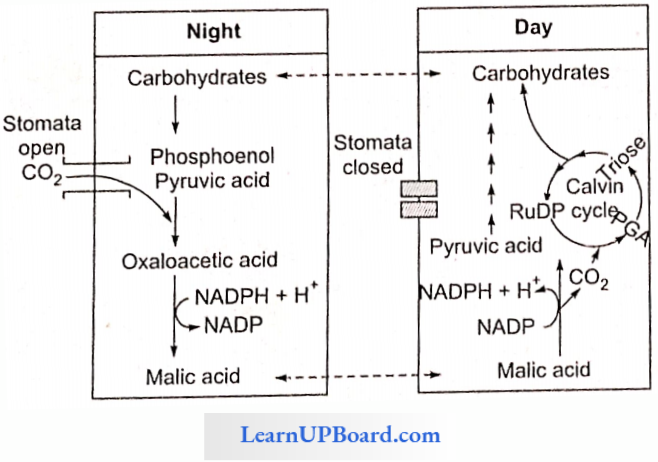
Blackman (1905) proposed the law of limiting factor which states that “when a biological process is conditioned as to its rapidity by a number of separate factors, the role of the process is limited by the pace of the slowest factor.”
NEET Biology Important Topics Factors Affecting Photosynthesis
Photosynthesis is regulated by many factors.
Light: Light is the most important factor for photosynthesis because it is used as a source of energy. Normally, plants utilize sunlight, but marine algae also use moonlight. Photosynthesis even occurs in electric light.
- Quality Of Light: Photosynthesis occurs in the visible part of the spectrum. Photosynthesis is maximum in polychromatic light or white light.
- Intensity Of Light: Only 1-4% of light is utilized in photosynthesis. In general, the rate of photosynthesis is higher in intense light than in diffused light. (Upto 10% light is utilized in sugar cane, i.e., the most efficient converter). For a complete plant, the rate of photosynthesis increases with an increase in light intensity, except for very high light intensity where the “solarization” phenomenon occurs, i.e., photo-oxidation of different cellular components including chlorophyll occurs.
CO2: The normal concentration of CO2 in the atmosphere is 360 ppm. By increasing CO2 concentration 15-20 times, the rate of photosynthesis increases, but after that it decreases. C4 plants show saturation at about 360 ppm.
Temperature: Generally photosynthesis is inhibited at 0°C, but some conifers even photosynthesize up to 35°C. Opuntia photosynthesizes up to 55°C. The Q10 value for photosynthesis is 2 up to about 40°C, and above it, the denaturation of enzymes begins, and hence, the rate of photosynthesis decreases.
H2O: As less than 1% of the total water absorbed by the plant is utilized in photosynthesis, so water rarely acts as a limiting factor. In water-deficient conditions, photosynthesis is found to be decreased.
Chlorophyll Content: I fall other factors are favorable, an increase in chlorophyll leads to an increase in photosynthesis.
Accumulation Of End Products: It results in a decrease in the rate of photosynthesis.
Photosynthesis In Higher Plants Points To Remember
Photosynthesis is an anabolic endergonic, oxidation-reduction process.
- PAR (photosynthetically active radiation) is the wavelength included in the range 400-700 nm.
- Destruction of chlorophyll due to high light intensity is called solarization.
- The most common limiting factor for photosynthesis is CO2.
Light Compensation Point: The light intensity at which the rate of photosynthesis is equal to the rate of respiration (in the morning and evening).
- DCMU (dichlorophenyl dimethyl urea)—a herbicide—inhibits PS-2 and oxygen release in the light phase.
- In C3 plants, more CO2 is released in light than in dark due to photorespiration.
- The yield of C3 plants is increased by increasing CO2 in the atmosphere but not in C4 plants.
- Chlorophyll-b absorbs more of a red wavelength than chlorophyll-a.
- Chloride ions stimulate the quick release of electrons from water.
- Phaeophytin is chlorophyll-a without Mg++.
- The size of quant some is about 180 x 155 x 100 Å
- In C4 plants, the bundle sheath cells possess chloroplasts without grana.
- Atriplex hastata show’s Calvin cycle whereas A triplex roseus shows the Hatch-Slack cycle.
- The reaction center in bacteria is B-890 and the reducing agent is NADH2.
- In bacterial photosynthesis, the type of photosynthesis is anoxygenic and cyclic.
CO2 Compensation Point: The CO2 concentration at which the rate of photosynthesis is equal to the rate of respiration.
For C3 plants → 50-100 ppm
For C4 plants → 0-10 ppm
NEET Biology Photosynthesis In Higher Plants Question And Answers
In the following questions, an Assertion (A) is followed by a corresponding Reason (R). Mark the correct answer.
- If both Assertion and Reason are true and the Reason is the correct explanation of the Assertion.
- If both Assertion and Reason are true, but the Reason is not the correct explanation of the Assertion.
- If Assertion is true, but Reason is false.
- If both Assertion and Reason are false.
Question 1. Assertion: In C4 plants, the chloroplasts of bundle sheath cells are granular.
Reason: PS-2 is mostly found in the appressed part of granum.
Answer: 4. If both Assertion and Reason are false.
Question 2. Assertion: Dark reactions of photosynthesis are temperature-controlled processes.
Reason: Most of the reactions are enzymatic in nature.
Answer: 1. If both Assertion and Reason are true and the Reason is the correct explanation of the Assertion.
Question 3. Assertion: Dark acidification of cytoplasm occurs in CAM plants.
Reason: Organic acids are decarboxylated during the night.
Answer: 3. If Assertion is true, but Reason is false.
Question 4. Assertion: Assimilatory power in photosynthesis is generated in ETS occurring in 23 thylakoid membranes.
Reason: They are needed for CO reduction.
Answer: 2. If both Assertion and Reason are true, but the Reason is not the correct explanation of the Assertion.
Question 5. Assertion: Light-harvesting complexes (LHC) on thylakoid membranes broaden the range of light absorption.
Reason: They transfer electrons to the reaction center.
Answer: 3. If Assertion is true, but Reason is false.
